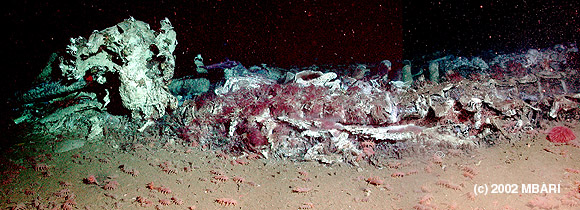Well son/daughter, their decomposing carcasses bloat up, sink to the deep, dark ocean floor, where other animals rip away their flesh and consume their bones*.

It may be a whole week of about vertebrates but I had to balance it out with a whale’s tale of death and decomposition in which at the end invertebrates eventually consume a whale.
*You may not actually want to tell your children this as it might initiate nightmares.
As discussed before, deep-sea systems (except for vents and seeps) are reliant upon food raining down from the surface. At the small end of the spectrum is marine snow-a mixture of bacteria, dead plankton parts, and feces. At the other, a dead whale falling to the bottom. Sinking can occur rapidly as pressure deflates the lungs. Most whales are also likely to sink to the ocean floor as opposed to stranding onshore, the latter accounting for less than 3% of the total deaths.
Whales are indeed a treat for the deep-sea floor. The whale fall is a nutrient rich food source loaded with lipids and proteins. A 40-ton carcass contains about 2 Mini Coopers worth of labile organic compounds. But don’t forget the bones laden with tasty lipids. They can possess another Mini Coopers worth of organic compounds. This is the equivalent of about 2000 years of food normally received on the abyssal plain. That being said calculations show that whale falls probably only account for 0.3% of the total amount of particulate organic carbon arriving at the deep-sea floor.
Once the whale arrives at the bottom, highly mobile scavengers such as hagfish, sharks, amphipods, and crabs remove a majority of the soft tissue. Luckily for the other species, these scavengers are messy eaters and the surrounding seafloor is littered with whale bits. The second stage of whale fall sees polychaetes, mollusks, and crustaceans foraging for these particles. Densities can reach 20,000-45,0000 per square meter. The next stage of a whale carcass is anaerobic microbial decomposition of the lipids within the skeleton. Sulfate reduction occurs in both the free-living bacteria and endosymbiotic bacteria within host bivalves and polychaetes. In the final stage, a variety of suspension feeding invertebrates utilize the elevated bones to feed in faster currents occurring off the bottom.
Currently ~30 species are known to be exclusive to whale falls. These include species from at least 5 different phyla.
Information and values were garnered from Craig Smith’s excellent review “Bigger is Better: The Role of Whales as Detritus in Marine Ecosystems.” In Whales, Whaling and Marine Ecosystems edited by James Estes.
Whale falls–islands of abundance and diversity in the deep sea
Whale carcass yields bone-devouring worms






Congratulations, you have won a Thinking Blogger Award! The link will explain it.
http://www.thethinkingblog.com/2007/02/thinking-blogger-awards_11.html
Currently ~30 species are known to be exclusive to whale falls.
Wow! Just amazing. Thanks for the interesting article about whale decomposition. :)
that look so nasty, how long had that been there